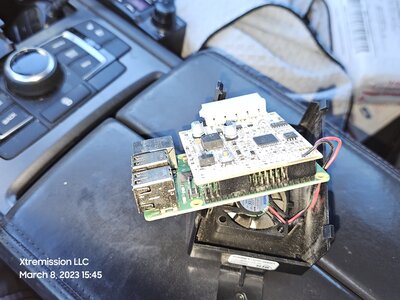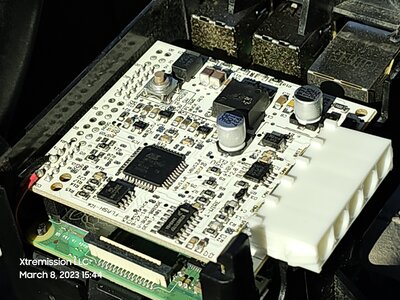Jim
RVF Supporter
- Joined
- Dec 18, 2019
- Messages
- 4,665
- Location
- North Carolina
- RV Year
- 2020
- RV Make
- Newmar
- RV Model
- Essex 4543
- RV Length
- 45
- Chassis
- Spartan
- Engine
- Cummins / I6 Diesel Pusher 605HP
- TOW/TOAD
- 2016 Jeep Rubicon
- Fulltimer
- No
Follow along with the video below to see how to install our site as a web app on your home screen.
Note: This feature may not be available in some browsers.
Yes. Granted, your phone app will think you are connecting to a Heartland trailer and you'll have an account at KIB that says you're the owner of said trailerOK, more specifically, can I monitor the temps inside the coach from a restaurant across town?
Yes, I have 2 versions backup actually - one from 4/22 and one from 1/23. It had an update as soon as I connected to it.@Suburbazine Thanks for the heads up. Now that’s a good find! Did you already make a copy of the sdcard for backup purposes?
If I recall there’s a “keepalive” sent on the network about every 3 seconds. Curious if it’s called something different. Content is hex BE 21 C3.
Let me know if I can be of assistance.
Oh the questions!! What does the daughter card look like? I assume it’s a HAT plugged into the 40 pin GPIO header? Do you know what pins it uses. Does it make sense to reverse engineer the HAT? build a compatible one? I already have a KIB remote solution, but willing to assist here. Actually let me know if you want to chat on the phone. Lots of questions. Can provide lots of insight.


Makes perfect sense that there are CAN pins. This is to get on a J1939 (powertrain) or RV-C (other than powertrain) networks in modern RVs. For example, most newer RVs, the Tire Pressure Monitoring System (TPMS) is on the RV-C network. So, the CAN pins would allow the KIBNet box to monitor those sensors.View attachment 17352View attachment 17353
Need to get a CH134 and dump the flash contents.
Not sure if it's better to reverse engineer, I am intrigued by the CAN pins which suggest the ability to signal on at least some automotive standard. Got the driver source code which might make it worthwhile to figure out how to drive independent of the KIB software.
It's designed with a converter onboard to power itself and the Pi from 12vdc. So extra circuitry which could be eliminated. It cannot be powered from the Pi, though the fan will run on Pi power.
The white connector is where everything connects, #1 V-Bus, #2 GND, #3 CAN L, #4 CAN H, #5 12Vdc. I couldn't get the correct harness so I use modified butt splices
I went in via the half bath switch, it already has a splitter harness on it. I made an adapter to the box using blue butt splicesI got one of these off eBay months ago and didn’t have a chance to dig into it so I threw it in a bin in the basement. Just came across your post and it totally renewed my interests!!! I’ve already got a couple pi boxes running zigbee sensors but I never thought about popping the cover off this box to see it was just a familiar friend!!!!
We full time and my wife is not fully behind me ‘hacking’ the coach (I’ve over complicated things in our previous house by tinkering) so I need to tread carefully.
Getting onto the box and getting it connected to my network should be childsplay…been hacking Linux since Linus first released it.
My question is, where did you plug it into the KIB V-Bus? Move got a Dutch Star so my thought is to tie it into the lighting control system in the half bath but would love to hear what you did.
I'm in...got the wifi all configured but couldn't do too much more...all my pi power supples are pi4 with usbc. I'm not getting clean enough power out of my powered USB hub for this box...whenever I enable the wifi, it gets low power warnings and reboots.I went in via the half bath switch, it already has a splitter harness on it. I made an adapter to the box using blue butt splices
Getting in is super easy with physical access, just edit a configuration on the SD card to force sbin at boot and the keys to the kingdom are yours. KIB used no mitigation techniques of any sort.
It's designed to be powered from KIB 12v on the bus. USB is limited by the fan and hat power draw. It's got a 5v 1A fan in the bottom (tapped off the Pi power from the hat) and it maxes out the acceptable limits for the USB port on the Pi. I tried feeding mine with a 3A power supply and it was the Pi limiting power, not the brick.I'm in...got the wifi all configured but couldn't do too much more...all my pi power supples are pi4 with usbc. I'm not getting clean enough power out of my powered USB hub for this box...whenever I enable the wifi, it gets low power warnings and reboots.
Amazon has one on the way, but I won't get it until mid-next week! Once it comes in and I verify it is stable, I'll connect it up to the V-Bus!
I'm in and up! Got held up because I normally setup everything manually and NetworkManager was messing with me (and I didnt know it).It's designed to be powered from KIB 12v on the bus. USB is limited by the fan and hat power draw. It's got a 5v 1A fan in the bottom (tapped off the Pi power from the hat) and it maxes out the acceptable limits for the USB port on the Pi. I tried feeding mine with a 3A power supply and it was the Pi limiting power, not the brick.
I’m hoping to be able to just use the pi HAT from the Kibnet to handle all the v-bus side of things. That said, Amazon is delivering a Logic Analyzer for me tomorrow.If you want to connect directly to the VBUS and communicate, the important things to know is that the VBUS communications is via J1850 protocol operating at 5V. For starters, you can use a Logic Analyzer to capture the signals and PulseView to decode them (it has a J1850 decoder).